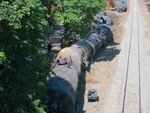
A 16-car oil train derailment caused a fire and left a small oil sheen on the Columbia River.
Conrad Wilson / OPB
Over the last several days, Oregon transportation officials have provided not only a clearer understanding of what may have led to this month’s oil train derailment in the Columbia River Gorge, but also the rigorous level of safety checks they say were performed just weeks before 16 cars left the tracks in Mosier, causing a riverside inferno.
Oregon officials said the tracks were inspected on April 27, just weeks before the June 3 derailment, using methods designed to ensure the tracks were safe enough to carry crude oil trains.
On Friday, railroad inspectors in Washington wrapped up a week of examining tracks between Pasco and Vancouver.
The inspections come the same week Washington Gov. Jay Inslee called on the U.S. Department of Transportation to do more to improve oil train safety.
The Federal Railroad Administration said it’s still investigating the incident.
Union Pacific said problems with metal fasteners may have contributed to the this month's derailment.
Related: Oil Trains In The Northwest
Oregon has asked federal transportation officials for a moratorium on oil trains in the Columbia River Gorge. But Washington, which also has rail tracks running on its side of the gorge, has not made a similar request. Officials there say any request would merely be symbolic, since railroads are largely governed by federal law.
“The preliminary indications, which are supported by UP’s findings as well, that the derailment was caused by broken lag screws,” said Hal Gard, with the Oregon Department of Transportation.
Gard, who runs ODOT’s rail and public transit division, said the screws hold the plates down on the ties. The rails on which the trains travel are fastened to the ties.
Gard was clear to point out that the FRA is still conducting an investigation. But on April 27, the section of track that later failed had passed a rigorous “crude oil rail track inspection to make sure they’re safe,” he said.
Gard said he sent a memo to the FRA requesting the moratorium because the inspections on the section of track didn’t show something was wrong.
“The fact that we did that level of inspection and we did not find evidence of that defect was incredibly alarming,” Gard said.
A spokesman for the FRA said it’s has been in regular contact with Gard since the derailment.
“Whenever FRA launches to investigate an incident, we look for the probable cause and contributing factors,” according to a statement from the agency. “If FRA finds that railroads need to make operational changes, we will direct them to do so.”
Officials in Washington said they’ll use the findings from this week’s track inspection to determine whether they’ll request more of the federal government.
“But states are limited in what we can do,” Inslee wrote in his letter to U.S. Transportation Secretary Anthony Fox. “Federal preemption severely limits our ability to respond to the emerging challenges resulting from increased oil train traffic.”
Among other things, Inslee asked the agency to speed up the transition of safer rail cars and to require railroads carrying crude oil and other hazardous material to slow down in rural areas.
Gard said he has a message for officials in Washington and elsewhere.
“What I would like Washington to recognize is that we had a problem with detecting a particular type of defect,” Gard said. “I think actually every state with a rail safety oversight program needs to pay attention to that fastening system and ask the same questions that we are.”